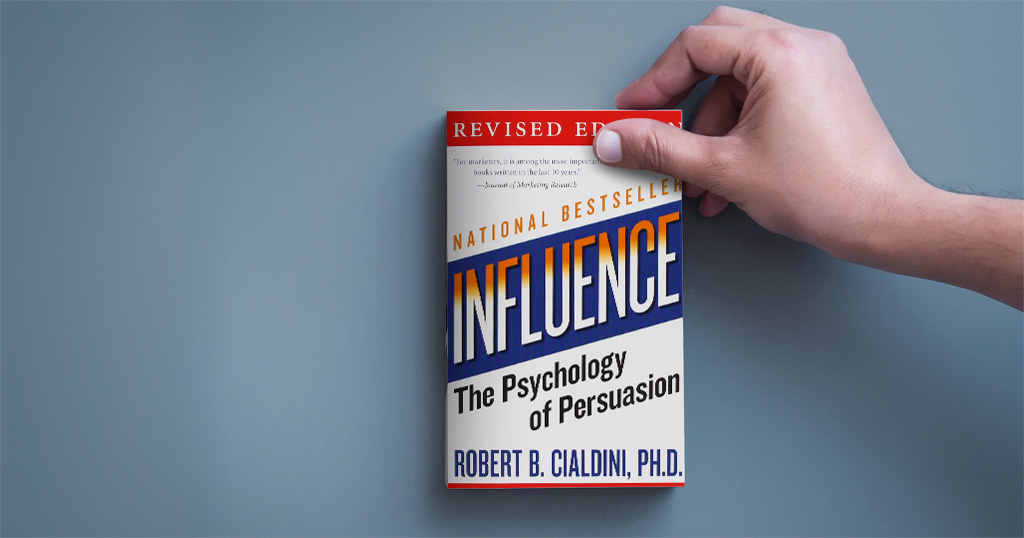You may have heard about Robert Cialdini’s book Influence: The Psychology of Persuasion, which in my opinion, is the best book to teach you the fundamentals of persuasion, influence, sales, and marketing.
While it’s a great book and the principles in it have basic fundamental truths, since it was written in the 80’s it can be difficult applying the principles in the 21st century. In this article, I’ll be going over the six principles outlined, and explain how they can easily be applied in a digital marketing context (since that’s what I have the most experience in).
1) Reciprocity: The idea that people want to help those that offer them something first. You’ll see this often when a store gives you a free sample, or a website gives you a trial membership. Since they gave you something for free, a part of you will feel obligated to return the favor. This can be doubly effective if done as a “reciprocity concession”. This is where you decline something, then someone makes a concession offer. Even though you declined the first initial offer, you’ll often feel obligated to concede with the second offer even if you’re not interested in that either.
How to apply it to Digital Marketing: Give people something for free to get them on your email list. This is known as a “lead magnet” (I guess since it attracts leads like a magnet). This could be a discount, free sample, an ebook, or a free consultation.
2) Consistency: The idea that people want to be consistent with themselves, to be seen as a stable person. People value being consistent over being logical. For example, if someone is collecting donations for a charity, they would get a better response if they first ask if a person is doing well in their life. If they answer yes, then they will feel more committed to help people in need, since they want to be consistent with their image of doing well (and therefore able to help others).
How to apply it to Digital Marketing: People generally tend to act consistent with previous behaviour. If you get a user to take an action on your site (like signup for a free trial or enter their email), they’ll feel more committed then if you try to make they buy right away
3) Social Proof: The idea that humans are social animals and respond to positive signals from others. If we see something is popular we assume it’s good.
How to apply it to Digital Marketing: Humans are social creatures. If they see others endorse something they will be more convinced by it. Including real testimonials, reviews, number of customers, and pictures of customers is a great way to show social proof in your website and in your ads.
4) Authority: The idea that we are naturally inclined to respect and take the advice of people in authority. Showing people that you (or your company) can be trusted in a field. This could be done through titles (Dr. etc.), clothing (someone that looks like a doctor), or trappings (indirect signals like where they work or what they drive).
How to apply it to Digital Marketing: On a sub-conscience level, we respond to signals of authority. If you’re not an authority yourself (or well known in the space you operate in), then on your website and in your ads, show logos of partners and other endorsements, like mentions in the press, credentials of the team, or famous clients that you work with.
5) Liking: The idea that we respond best to people that are “like” us . Show your customers you are “one of them”! That means if you are targeting a certain demographic or audience and you’re running an ad with an image of people in it, use images that have the same demographic of people in the photo.
How to apply it to Digital Marketing: Humans respond better to people that are like them. If you show people in your ad, choose images and videos that highlight people that look like your customer (same demographics, gender, nationality etc.). Even small changes in dress in a culture can go a long way in making people relate to your ad and responding better. For example, if your ad is targeting Arab businesswomen, find actual pictures of them (ideally pictures of your real customers). It may seem like not a big deal, but it makes a big difference.
6) Scarcity: The idea that whenever an opportunity or an item is viewed as in low supply, we assign more value to it. Double scarcity is having the knowledge of the scarcity be unknown (for example, a secret limited sale only some people know about).
How to apply it to Digital Marketing: It is ingrained in us to avoid scarcity. If you highlight something is in limited supply (a limited offer, limited stock), if it’s genuine, people will respond. You can also have time based offers, supply based offers, or promotional based offers. You shouldn’t fake this though, because people will catch on.
Want to learn to master digital marketing in one week? Attend one of the AstroLabs upcoming digital marketing courses (links below for different geographies)!
Digital Marketing Course Dubai
Digital Marketing Course Abu Dhabi






